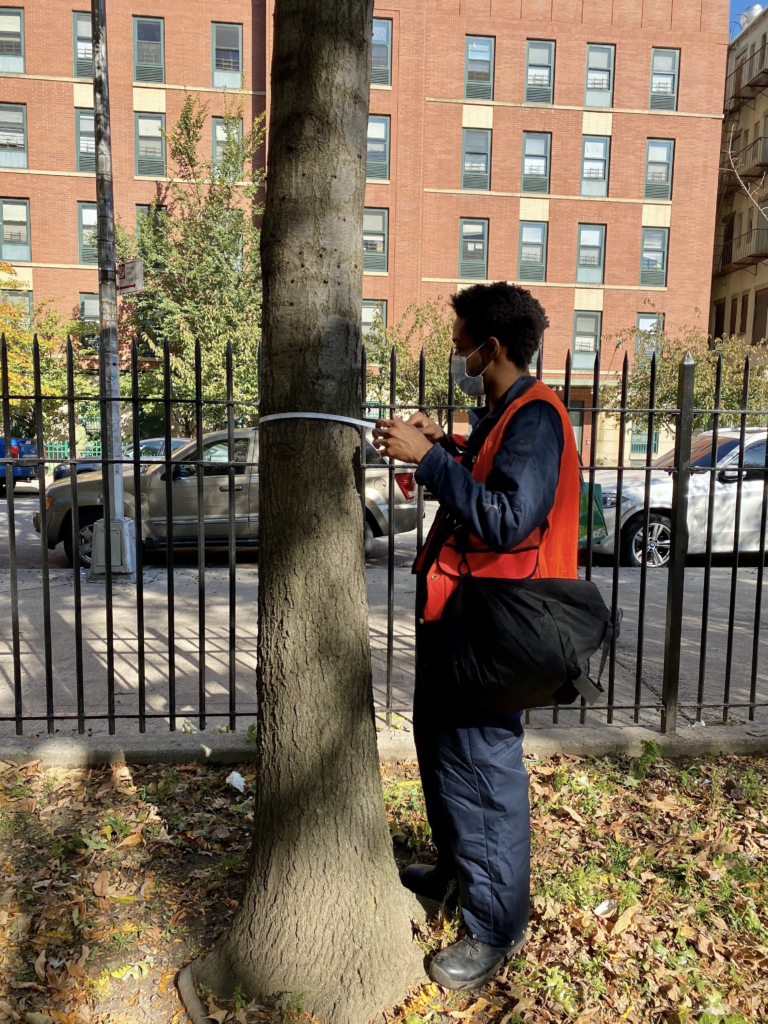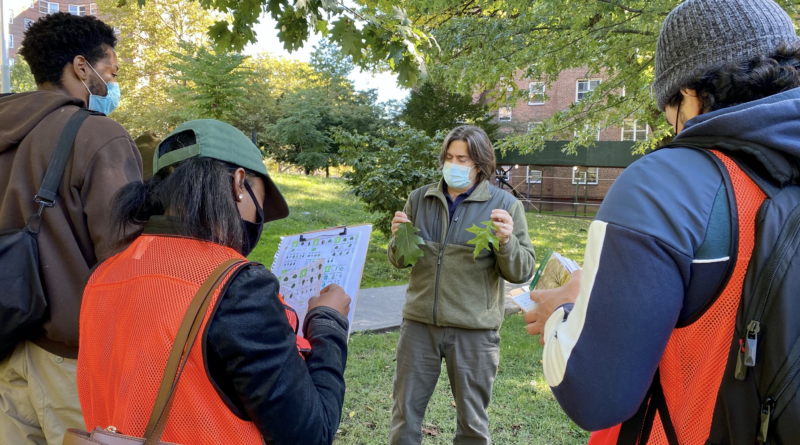NYCHA, Green City Force Inventory Thousands of Trees Across 18 Campuses
Equipped with tape measures and a mobile app, a group of current and former NYCHA residents were on a mission this past fall to document a segment of the Authority’s tree canopy to better examine the trees’ positive impacts on the surrounding community.
Over the course of two months, the crews inspected more than 3,000 trees of varying species across 18 NYCHA developments in Manhattan, Brooklyn, and the Bronx. In collaboration with The Nature Conservancy, the U.S. Forest Service, and the New York City Parks Department, NYCHA partnered with Green City Force to conduct the tree inventory and evaluate how green spaces are used in neighborhoods that are susceptible to higher temperatures, including East Harlem, Brownsville, and the South Bronx.
“We wanted to really know how to quantify the ecological and social value that NYCHA’s trees provide, and to perform green space and tree management recommendations,” said Asia Mae Somboonlakana, NYCHA’s Project Manager for the inventory.
By conducting its first tree inventory to this scale, NYCHA is seeking to study the benefits that its trees provide in relation to energy savings, cooling, and stormwater retention, as well as to determine potential climate-related threats the trees may face in the future, said Siobhan Watson, Program Manager in NYCHA’s Recovery and Resilience Department.
“Our trees are one of our most important assets in mitigating extreme heat,” Ms. Watson noted. “NYCHA is really fortunate to have its tree canopy cover, so we’re looking both at quantifying the value that provides, as well as how we can protect it going into the future.”
To conduct the tree cataloguing effort, NYCHA called upon its workforce development partner Green City Force (GCF), which trains NYCHA young adults for green jobs. Six GCF members worked in teams of two people per borough to perform a “full run-through of documenting,” which involved measuring the trees for an age estimate, inspecting their health condition, and identifying any potentially harmful insects or animals, said GCF field supervisor Josh Owens.

The inventory project provided an opportunity for the GCF crews to work in urban forest areas near their homes, as well as a learning experience on how to properly document trees and determine their specific species, Mr. Owens said. Among the most popular varieties tracked across the 18 properties were London plane, crab apple, and oak trees.
“It’s important to give these jobs to people coming from these communities, and also to learn about sustainability and acquire skills that they can take on,” said Mr. Owens, who grew up in Brooklyn’s Red Hook Houses. “We’ve been doing tree warden [care and maintenance] projects with NYCHA in the past few years, and it’s been a stepping stone and a platform to bigger things.”
As part of the Connected Communities initiative, NYCHA also collected observational surveys on how open spaces are used throughout the campuses, including where residents typically spend time and their favorite activities to do outdoors. In addition, the crews aimed to discover residents’ opinions about the development’s trees and their impact on the community. Some residents spoke highly of the trees for their beauty and for creating a needed source of shade, while others inquired about NYCHA’s tree maintenance efforts.
“By people just seeing you out there doing some measurements on the trees, it creates a conversation,” Mr. Owens said of the engagement with residents.
After spending weeks up close with NYCHA’s trees and learning more about their biology, the GCF teams have acquired new skill sets and expressed an interest in pursuing similar environmental projects.
“Connecting with that and establishing a broader connection with trees and forestry was good for those guys,” Mr. Owens said.
Following the on-site documentation of the trees, NYCHA is working to analyze the data to determine the ecological benefits and health status of the tree canopy, and to identify threats to the canopy and resilience needs. While NYCHA hopes to conduct future inventories, results from this first initiative will be incorporated into the Authority’s forthcoming climate adaptation plan.
“We are trying to understand how we can make sure that any investment we are able to put into our grounds is done in a resilient way and in a way that continues to protect NYCHA’s campuses in the future,” Ms. Watson said.







